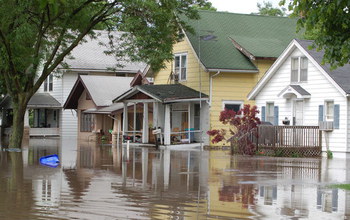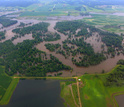Hola amigos: A VUELO DE UN QUINDE EL BLOG., hemos recibido información de la Fundación Nacional de Ciencias de Los Estados Unidos, donde ellos manifiestan que sus científicos han comprobado la mayor frecuencia de inundaciones en el Medio Oeste de los Estados Unidos. La región central de Estados Unidos y los estados vecinos han sufrido inundaciones cada vez más frecuentes durante el último medio siglo, según los resultados de un nuevo estudio.
Los investigadores, afiliados a la Universidad de Iowa (UI) y financiado por la National Science Foundation (NSF), basaron sus hallazgos en registros diarios recogidos por el Servicio Geológico de EE.UU. en 774 estaciones de aforo en 14 estados desde 1962 hasta 2011, una colección de datos período en común para todas las estaciones.
Los investigadores, afiliados a la Universidad de Iowa (UI) y financiado por la National Science Foundation (NSF), basaron sus hallazgos en registros diarios recogidos por el Servicio Geológico de EE.UU. en 774 estaciones de aforo en 14 estados desde 1962 hasta 2011, una colección de datos período en común para todas las estaciones.
Ellos encontraron que 264, o 34 por ciento, de las estaciones tuvo un incremento en la frecuencia del número de eventos de inundación, mientras que sólo 66 estaciones, 9 por ciento, mostraron una disminución.
"Hemos estado experimentando un mayor número de grandes inundaciones", dice Gabriele Villarini, IU ingeniero civil y ambiental y autor correspondiente de un artículo que informa de los resultados publicados hoy en la revista: Nature Climate Change.
"Hemos estado experimentando un mayor número de grandes inundaciones", dice Gabriele Villarini, IU ingeniero civil y ambiental y autor correspondiente de un artículo que informa de los resultados publicados hoy en la revista: Nature Climate Change.
Floods happening more often over past half-century
Las inundaciones ocurren con más frecuencia durante el pasado medio siglo
 Credit and Larger Version |
The U.S. Midwest region and surrounding states have endured increasingly more frequent floods during the last half-century, according to results of a new study.
The researchers, affiliated with the University of Iowa (UI) and funded by the National Science Foundation (NSF), based their findings on daily records collected by the U.S. Geological Survey at 774 stream gauges in 14 states from 1962-2011, a data collection period in common for all the stations.
They found that 264, or 34 percent, of the stations had an increase in frequency in the number of flood events, while only 66 stations, 9 percent, showed a decrease.
"We have been experiencing a larger number of big floods," says Gabriele Villarini, UI civil and environmental engineer and corresponding author of a paper reporting the results published today in the journal Nature Climate Change.
The findings likely come as no surprise to millions of people in the Midwest and bordering states.
During the past several decades, large floods have plagued the region in 1993, 2008, 2011, 2013 and again in 2014.
"Floods have the potential to take an immense toll on society in economic damages and other long-term effects," says Anjuli Bamzai, program director in NSF's Division of Atmospheric and Geospace Sciences, which funded the research.
"This study looks at how such events may have changed over recent decades across the central U.S."
The floods caused agricultural and other economic losses in the billions of dollars, displaced people and led to loss of life.
"There is a pattern with increasing frequency of flood events from North Dakota south to Iowa and Missouri and east into Illinois, Indiana and Ohio," says Iman Mallakpour, UI civil and environmental engineer and lead author of the paper.
"We related this increasing number of big floods to changes in rainfall and temperature," adds Villarini.
"There was an overall good match between the areas with increasing frequency of floods and areas experiencing increasing frequency of heavy rainfall."
Seasonal analysis revealed that most of the flood peaks in the upper Midwest occur in the spring and stem primarily from snowmelt, rain falling on frozen ground, and rain-on-snow events.
Spring--a season with heavy rains--also has the strongest increase in temperature over most of the northern part of the region studied.
The findings fit well with current thinking among scientists about how the hydrologic cycle is being affected by climate change.
In general, as the atmosphere becomes warmer, it can hold more moisture. One consequence of higher water vapor concentrations is more frequent, intense precipitation.
Villarini says the current study did not attempt to link the increase in the number of episodes with climate change.
"What causes the observed changes in precipitation and temperature is not something we have addressed because of the difficulties in doing so based on observational records," he says.
The study region included Iowa, Illinois, Indiana, Wisconsin, Ohio, Michigan, Minnesota, Kansas, Nebraska, Missouri, West Virginia, Kentucky, North Dakota and South Dakota.
The method used involved establishing a threshold level of two flood events per year, on average, for each of the 774 stream gauges in the study.
To avoid counting the same event twice, the researchers allowed for the recording of only one event within a 15-day period.
The research was also funded by the U.S. Army Corps of Engineers Institute for Water Resources, the Iowa Flood Center and IIHR-Hydroscience & Engineering.
-NSF-
Media Contacts Cheryl Dybas, NSF, (703) 292-7734, cdybas@nsf.gov
Gary Galluzzo, University of Iowa, (319) 384-0009, gary-galluzzo@uiowa.edu
Gary Galluzzo, University of Iowa, (319) 384-0009, gary-galluzzo@uiowa.edu
The National Science Foundation (NSF) is an independent federal agency that supports fundamental research and education across all fields of science and engineering. In fiscal year (FY) 2015, its budget is $7.3 billion. NSF funds reach all 50 states through grants to nearly 2,000 colleges, universities and other institutions. Each year, NSF receives about 48,000 competitive proposals for funding, and makes about 11,000 new funding awards. NSF also awards about $626 million in professional and service contracts yearly.
Useful NSF Web Sites:
NSF Home Page:
http://www.nsf.gov
NSF News:
http://www.nsf.gov/news/
For the News Media:
http://www.nsf.gov/news/newsroom.jsp
Science and Engineering Statistics:
http://www.nsf.gov/statistics/
Awards Searches:
http://www.nsf.gov/awardsearch/

A river--and furniture--ran through it: Floods in Cedar Rapids, Iowa, carried belongings with them.
Credit and Larger Version

A waterloo for Waterloo, Iowa: Waters spilled out of riverbanks and overran streets.
Credit and Larger Version

Are U.S. Midwest floods more frequent? Researchers say yes. Pictured: July 2014, Iowa flood.
Credit and Larger Version

Floods have caused agricultural and other economic losses in the billions of dollars.
Credit and Larger Version

Cars floated down avenues in the Midwest after heavy rains besieged the region.
Credit and Larger Version
The National Science Foundation (NSF)
Guillermo Gonzalo Sánchez Achutegui
ayabaca@gmail.com
ayabaca@yahoo.com
ayabaca@hotmail.com
Inscríbete en el Foro del blog y participa : A Vuelo De Un Quinde - El Foro!

No hay comentarios:
Publicar un comentario